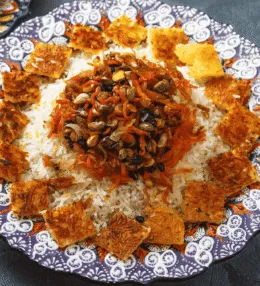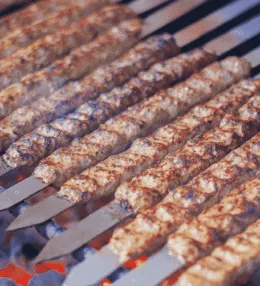
- View
Table of Contents
TogglePašticada is the sumptuous beef stew of Dalmatia, a dish that turns a quiet afternoon into a slow unfolding of aromas. The meat is marinated, braised with wine and fruit, then served with soft gnocchi. It feels celebratory yet homely, a plate that invites lingering conversation.
In coastal towns from Split to Šibenik, pašticada appears at weddings and Sunday tables. The sauce is glossy and gently sweet, threaded with warm spice and a hint of vinegar. Each mouthful tells of patient cooking and the Adriatic rhythm that favours steady care.
What draws people in is the contrast of textures. Fork tender beef rests beside pillowy gnocchi that soaks up every last drop. The flavours arrive in layers, first bright, then mellow and savoury. It is generous food, meant to be shared across a long meal.
Season after season, families return to it because it feels honest. The pot sends out aromas of wine, spice, and slow cooked beef that fill the kitchen. It sets an easy pace for the day, inviting people to pull up a chair and stay awhile.
Want to dive deeper into Croatian Cuisine? Don’t miss our post on Traditional Croatian Foods to Try
What Is Pašticada?
Pašticada is beef that has been marinated with garlic, herbs, and wine vinegar, then slowly braised with onions, prunes, and local wine. The result is a deep, velvety sauce that clings to the meat. Gnocchi arrive as faithful companions for the rich gravy.
Cooks often prick the beef and tuck in slivers of garlic and carrot before the marinade. Some add pancetta or cloves for nuance, others prefer a simpler path. The goal remains tenderness and balance, where savoury notes mingle with gentle sweetness from fruit.
Service is straightforward. The beef is sliced and napped with its sauce, then partnered with gnocchi or sometimes soft bread. A scatter of parsley lifts the finish. The dish feels refined without fuss, letting careful preparation speak rather than showy adornment.
Ingredients and Taste
Beef leg or rump is common, chosen for its ability to soften over a long gentle braise. Onions form the base, cooked until sweet. Dalmatian red wine deepens the pot, while prunes or dried figs lend a rounded fruit note that plays against vinegar and herbs.
Bay leaves, rosemary, and a whisper of nutmeg bring warmth. Tomato paste adds colour and body without overpowering the fruit. Olive oil gives gloss, and stock steadies the flavour. Gnocchi are light yet sturdy, ready to welcome spoonful’s of the savoury sauce.
The taste unfolds in stages. First a bright spark from the marinade, then the soft sweetness of fruit, finally the richness of beef and wine. Nothing shouts. Instead, flavours settle into harmony, leaving a clean finish that invites another small, thoughtful bite.
Good gnocchi are a quiet triumph. Light, slightly chewy, and ready to drink in sauce. Some cooks enrich the pot with a knob of butter at the end; others finish with lemon zest. Either way, the plate carries warmth without slipping into heaviness.
A Taste of History
Pašticada lives in Dalmatia’s memory as both family treasure and festival centrepiece. Its method echoes Venetian and Mediterranean techniques, where sour and sweet meet in the same pot. Over centuries, local cooks shaped those ideas to suit their own larder.
Trade once brought wine, spices, and dried fruit along the coast, enriching everyday stews. Households adapted recipes to what was at hand, which is why versions vary from town to town. Some lean spicier, others sweeter, all recognisably part of the same lineage.
Today the dish holds a firm place at rites of passage, from baptisms to weddings. Restaurants serve it with pride, yet the finest memories often come from home kitchens. A pot simmering on a quiet stove, a table set for many, and time given to do the rest.
How to Make Pašticada (Beef Stew with Gnocchi)
Pašticada is a celebrated Dalmatian dish, slow cooked beef enriched with red wine, root vegetables, and Mediterranean spices, often served on festive occasions. Expect tender meat, a velvety sauce, and the perfect pairing with gnocchi. See the recipe card at the bottom for printable directions
Ingredients
For the beef and marinade
- 1.2 kg beef (silverside or rump, tied with kitchen twine)
- 3 cloves garlic, cut into slivers
- 2 carrots, sliced
- 2 celery stalks, sliced
- 2 onions, quartered
- 150 ml red wine vinegar
- 300 ml dry red wine
- 3 bay leaves
- 5 whole cloves
- 1 cinnamon stick
- 1 tsp black peppercorns
For the stew
- 4 tbsp olive oil
- 100 g pancetta, diced
- 2 tbsp tomato paste
- 150 g prunes, pitted
- 2 tbsp raisins
- 500 ml beef stock
- Salt and freshly ground black pepper, to taste
For serving
- Freshly cooked gnocchi
- Chopped parsley
Cooking Instructions
Step 1: Marinate the beef
To begin, pierce the beef with a small knife and insert garlic slivers inside. Place beef in a non-reactive dish with carrots, celery, onions, bay leaves, cloves, cinnamon, peppercorns, vinegar, and wine. Cover and marinate overnight in the fridge. Move to searing the meat.
Step 2: Sear the beef
Remove the beef from the marinade, pat dry, and set marinade aside. Heat olive oil in a large pot and sear beef on all sides until browned. This step locks in flavour. Transition to adding pancetta.
Step 3: Add pancetta and vegetables
Add diced pancetta and vegetables from the marinade to the pot. Cook gently until softened and fragrant. Stir in tomato paste. Proceed to deglaze.
Step 4: Deglaze with marinade
Pour the reserved marinade into the pot, scraping the base to release browned bits. Bring to a simmer, then lower the heat. Transition to adding prunes and raisins.
Step 5: Add dried fruits and stock
Add prunes, raisins, and beef stock. Stir well, ensuring the beef is mostly submerged. Cover partially with a lid. Move to long simmering.
Step 6: Slow cook the beef
Simmer gently for 2.5–3 hours, turning the beef occasionally, until fork tender. Add extra stock if the sauce reduces too quickly. Move to blending the sauce.
Step 7: Blend the sauce
Remove the beef and discard cinnamon stick and bay leaves. Purée the sauce with a hand blender until smooth. Return beef to the sauce. Transition to preparing gnocchi.
Step 8: Prepare gnocchi
Cook gnocchi in salted boiling water until they float to the surface. Drain and toss lightly in olive oil to prevent sticking. Move to slicing beef.
Step 9: Slice the beef
Slice the beef against the grain into thick pieces. Return slices to the sauce to stay warm. Move to serving.
Final Step: Serve
Plate gnocchi first, top with slices of beef, and ladle over the rich sauce. Garnish with fresh parsley. Presentation tip: serve in a wide, shallow bowl for a rustic yet elegant finish.
Variations and substitutions
- Beef cuts: Substitute silverside with brisket or chuck if preferred.
- Pancetta: Use smoked streaky bacon if pancetta is unavailable.
- Prunes and raisins: Replace with dried figs or sultanas for similar sweetness.
- Wine: If red wine vinegar is unavailable, use a mix of balsamic vinegar and lemon juice.
- Gnocchi: Traditionally paired but can be substituted with pasta or mashed potatoes.
Cooking Tips for Perfect Pašticada
- Always marinate the beef overnight for deep flavour.
- Tie the beef with kitchen twine to maintain shape during cooking.
- Balance sweet and sour by adjusting prunes and vinegar.
- Use a heavy bottomed pot for even heat distribution.
- Allow the stew to rest for 15 minutes before serving to let flavours settle.

Croatian Pašticada (Beef Stew with Gnocchi)
Ingredients
For the beef and marinade
- 1.2 kg beef silverside or rump, tied with kitchen twine
- 3 cloves garlic cut into slivers
- 2 carrots sliced
- 2 celery stalks sliced
- 2 onions quartered
- 150 ml red wine vinegar
- 300 ml dry red wine
- 3 bay leaves
- 5 whole cloves
- 1 cinnamon stick
- 1 tsp black peppercorns
For the stew
- 4 tbsp olive oil
- 100 g pancetta diced
- 2 tbsp tomato paste
- 150 g prunes pitted
- 2 tbsp raisins
- 500 ml beef stock
- Salt and freshly ground black pepper to taste
For serving
- Freshly cooked gnocchi
- Chopped parsley
Instructions
- To begin, pierce the beef with a small knife and insert garlic slivers inside. Place beef in a non-reactive dish with carrots, celery, onions, bay leaves, cloves, cinnamon, peppercorns, vinegar, and wine. Cover and marinate overnight in the fridge. Move to searing the meat.
- Remove the beef from the marinade, pat dry, and set marinade aside. Heat olive oil in a large pot and sear beef on all sides until browned. This step locks in flavour. Transition to adding pancetta.
- Add diced pancetta and vegetables from the marinade to the pot. Cook gently until softened and fragrant. Stir in tomato paste. Proceed to deglaze.
- Pour the reserved marinade into the pot, scraping the base to release browned bits. Bring to a simmer, then lower the heat. Transition to adding prunes and raisins.
- Add prunes, raisins, and beef stock. Stir well, ensuring the beef is mostly submerged. Cover partially with a lid. Move to long simmering.
- Simmer gently for 2.5–3 hours, turning the beef occasionally, until fork tender. Add extra stock if the sauce reduces too quickly. Move to blending the sauce.
- Remove the beef and discard cinnamon stick and bay leaves. Purée the sauce with a hand blender until smooth. Return beef to the sauce. Transition to preparing gnocchi.
- Cook gnocchi in salted boiling water until they float to the surface. Drain and toss lightly in olive oil to prevent sticking. Move to slicing beef.
- Slice the beef against the grain into thick pieces. Return slices to the sauce to stay warm. Move to serving.
- Plate gnocchi first, top with slices of beef, and ladle over the rich sauce. Garnish with fresh parsley. Presentation tip: serve in a wide, shallow bowl for a rustic yet elegant finish.
Nutrition
You May Also Like







Leave a Review